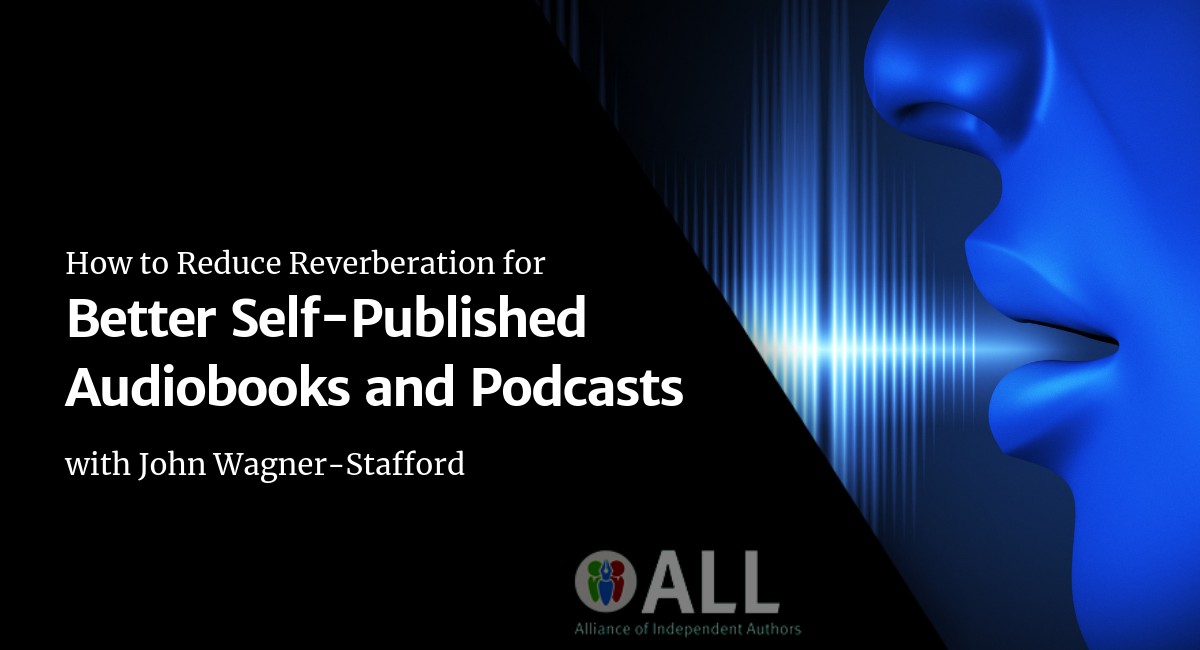Self-published audiobooks and podcasts can and should sound great. Whether you’re narrating your audiobook, hosting a podcast, or being interviewed for a podcast or other broadcast medium, and you’re doing it from your home office, there’s a lot more to consider than microphone quality and diction. John Wagner-Stafford leverages his background as a professional musician and recording studio producer to offer these tips for getting great sound.

Good quality sound is important for your self-published audiobooks and podcasts. In fact, it could make or break your audio project. When you are setting out to work in audio format, any audio format, there are a few tricks to getting studio-quality sound. These are tricks that can make an inexpensive microphone sound awesome, and without which even the most expensive recording gear won’t help you.
Taming the Sound Waves
Sound waves bounce around the room the way words bounce around in our heads as we write. Just as we need to tame those bouncing words and help them fall neatly onto the page, we also need to tame those bouncing sound waves to get professional-quality results.
The recording studios I worked in were impressive in their design and surreal in how they sounded when entering them from the outside. The reason for this is reverberation, or lack thereof.
Creating Your Recording Environment
There are three main considerations when creating an excellent sound recording environment.
- Construction of the room
- External environment sound
- Reverberation
Most of us aren’t building a recording studio, or even rebuilding a room in our home to turn it into a recording studio. And we have little to no control over the birds, sirens, planes flying overhead, kids playing in the park, or the barking dogs making noise in the external environment.
That leaves us with “reverberation,” and this is definitely something we can control.
Reverberation
Reverberation is unwanted when recording your voice for audiobooks. Sound waves exit our mouths and move in all directions. Flat, parallel surfaces make a great playground for sound waves, enabling them to bounce around, back and forth, changing their angles slightly and bouncing some more. Shiny, nonporous, non-textured surfaces offer no dampening receptacles for the sound waves to get absorbed into.
Depending on the proximity and type of surfaces (like walls) in your recording room, sound waves will bounce and reflect repeatedly until they are absorbed and die. But until that happens, it means an echoey, hollow-sounding, not-fun-to-listen-to recording.
How to Deaden the Room
There are some simple remedies to minimize the reverberation in a room you can do for little to no cost. The core principle is to minimize reflection by adding as much sound absorption as possible.
How do you do this?
1.Change angles.
I’m not suggesting you literally change the angle of the four walls inside the room you use to record your audio book. That would be a rebuild and not usually practical. Instead, you can add items to the walls which, when mounted, break up the parallel nature of the walls and minimize the reverberation.
- Picture-frame-like boxes covered with porous material (burlap or loose blankets) surrounding sponge or soft foam (the type used for mattresses or cushions) mounted on a large percentage of the wall area at a slight angle will go a long way
- Adding or rearranging furniture throughout the room, ensuring you’re choosing fabric- or other soft material-covered furniture (chrome and glass aren’t going to help much)
- Draping decorative blankets across the ceiling to help prevent reflections from floor to ceiling
- Covering the floor with a plush area carpet
- Covering the table your computer and any recording equipment is sitting on to absorb sound waves immediately in front of the microphone
- Get creative if you have to. Bring a patio umbrella indoors, move your recording setup underneath, and drape it with blankets.
2. Choose a Small Room
Choosing a small room to work in is usually best. My wife is recording her recent release with her head in our clothes closet, with her computer and microphone set on some towels. She looks really funny, but the sound quality is good.
Great Sounding Self-Published Audiobooks and Podcasts
These are simple, inexpensive actions you can take to minimize the sound reflection and give your narrator’s voice a more intimate, warm sound and draw the listener in.
here are a few tricks to getting studio-quality sound for your #selfpublished #audiobook or #podcast, and it's not about the microphone @JWS_2greatguys @ingeniumbooks Share on XOVER TO YOU
What tricks have you used to reduce reverberation in your self-published audiobooks and podcasts? We'd love to hear them, so leave a comment below.
IF YOU ENJOYED THIS POST…
…here are a few others from the ALLi archive.





Aiming yourself so that you are speaking into the corner of the room can help minimize reverberation. Also, if you have a dressing screen or a freestanding coatrack and a moving blanket or two, you can put them behind where you are standing/sitting to create a deader and quieter receding space.
Nice ideas, thanks! Will try to do…